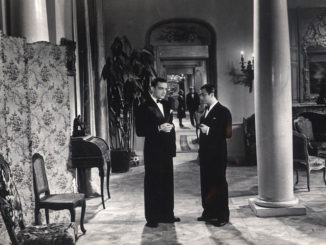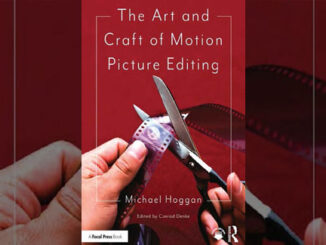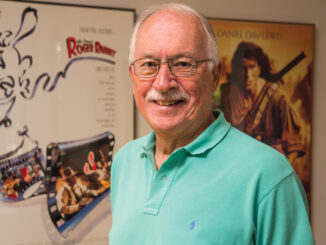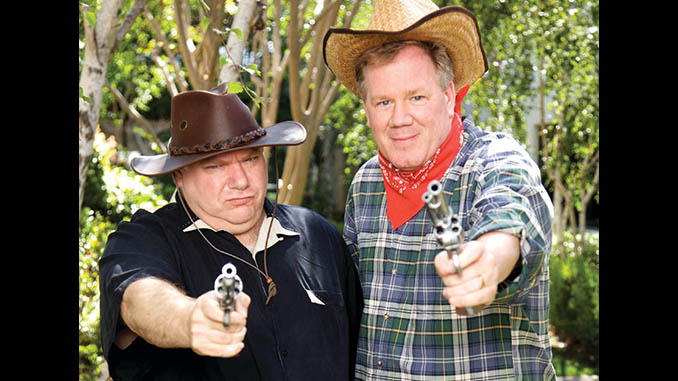
by Michael Goldman portraits • by Deverill Weekes
Through several TV projects and five feature films, the relationship between editor Dan Lebental, ACE, and director Jon Favreau has evolved to the point where Lebental views himself as Favreau’s creative consultant when it comes to helping the director figure out exactly where his movies are going.
This was certainly the case, both men say, during their collaboration on Favreau’s latest feature, Cowboys & Aliens, opening July 29 through DreamWorks and Universal Pictures.
Lebental co-edited the piece with Jim May, but with a long history working with Favreau, he was part of the project from the outset. May then came on board as principal photography ended to reduce schedule pressure as the number and bandwidth of the visual effects shots expanded. He says part of his job was to “free Dan up to look at the bigger picture with Jon.”
And that’s precisely what Lebental did, becoming, according to Favreau, one of the most crucial creative influences on the director throughout the creation of the film. “I’m sort of a filter for Jon, and then he decides on things,” he says. “I’m his consigliore—I advise strongly based on what I believe, and then he decides. I’m a forceful personality whom he chooses to have around, and therefore I will challenge him or suggest things even when he’s firm on what he wants. It’s not about getting my way—it’s about the quest to find clarity in the edit. I’m trying to help him cut through the fog and find the movie that he wants to show, so I keep suggesting things until I know he’s sure about everything.”
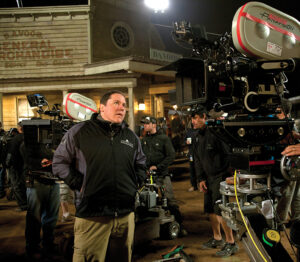
Favreau confirms the notion, saying that Lebental has “bold ideas—not ones I always agree with, but I like them anyway because I like a strong point of view in the editing room. He’s a very active partner for me,” the director attests. “The last thing I want is an editor who is there solely to execute my vision. I want someone to present a counterpoint to the way I think we should go. Conversations can often lead to something different than either of our original POVs, and that is best for the film; that’s how you get to the truth of it.”
Mixing Genres
In the case of Cowboys & Aliens, the essential challenge for the director and both editors was how to find a rhythm that balanced the story neatly between elements from two, separate genres— the traditional Western and the modern sci-fi action piece. The movie, after all, tells the story of an alien invasion in Arizona in the late 1800s, with only a group of startled cowboys—led by two rivals who hate each other’s guts (played by Daniel Craig and Harrison Ford)—try- ing to halt the onslaught.
Although those two genres are part of the film’s DNA, both men concluded very early that Cowboys & Aliens would be, as Lebental puts it, “grounded solidly in the Western world, and therefore, we weren’t about to impose on it and mash it up with other styles; we weren’t going to dishonor the genre.”
Indeed, Favreau suggests the foundation of Cowboys & Aliens was meant to be about as classic a Western as one can get. This is a major reason why he nixed the idea of making Cowboys & Aliens a 3- D picture, since he felt it would distract from the concept of a classic Western. “We felt it would be like commenting on the Western [by adding a modern digital layer over stylized imagery],” Favreau says. “So we decided that 2-D anamorphic on film was a better match for this material.”
In fact, the director’s references and inspirations were a series of Western titles neatly organized and presented to him on an iPad by executive producer Steven Spielberg. That collection was skewed by Spielberg’s preferences for John Ford films like The Searchers and Stagecoach, along with such other classics as Red River, High Noon and Unforgiven, plus personal favorites of Favreau’s, including Sergio Leone’s famous Spaghetti Westerns. Those influences left the director juggling a dichotomy that Lebental and May would help him sort out in the editing room—how to insert modern, sci-fi, alien-invasion elements into a classic Western story arc.
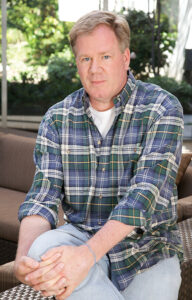
“We felt it was important to keep a traditional eye,” Favreau says. “Obviously, the new wrinkle is throwing in the alien invasion. But, in a weird way, that made it more akin to traditional Westerns than if it didn’t have that element. It’s irresponsible today to be xenophobic and present Indians or other cultures as allegorical evil, like earlier Westerns did. Back in those days, the Indian was the abstraction of the scary, unknown other. Now, they are just as human as cowboys, which is the right thing. But you lost some of those story elements as a result. With aliens, we were able to return to the allegorical evil that the cowboys are facing. So we felt we could honor tradition- al Western pacing that way.”
This requirement challenged the editors, but also led to some good, old-fashioned creative fun in melding the genres together. In a sequence where the character Jake (Craig) gets to fire the mysterious alien weapon that is stuck to his wrist, May recalls, “Jon evoked the classic Western gunslinger when creating the scene. And trying to stay true to that, I let that motif drive the pace and shot selection. I found beats and looks from Jake where he is like the Sundance Kid—hyper-confident, firing away in controlled mayhem that mows down bad guy after bad guy, never sweating.
“But as the scene evolves, we also channel that classic scene from Aliens in which Private Hudson looks up into the ceiling tiles and sees dozens of aliens bearing down on his team,” continues May. “Jake unleashes—I mean really unleashes—his wrist weapon. Then, at the end of the scene, where normally the gunslinger would calmly blow smoke off the barrel of his gun, Jake calmly adjusts his hat and looks down, and this high-tech visual display screen turns off on his blaster, which tells him the alien threat is over. It’s a really fun, cross-genre homage.”
Perfecting the pacing and tone for such sequences was the trick, of course, but the filmmakers say the pressing need to produce a killer reel for presentation at the Comic-Con International 2010 show last summer helped them on this mission of discovery. The need to sell the movie to fans long in advance of its completion caused Favreau to “go a little bit P.T. Barnum,” in Lebental’s words. Therefore, the director structured his shoot so that he would have elements for the movie’s big set piece—an attack on a small Western town by alien invaders that occurs early in the story—in place for Lebental to cut in time for the trade show.
“When we put it together, it ended up becoming the foundation of telling us what the tone of the movie was,” says Lebental. “We found our way to put the two genres together. To me, it was shocking how complimentary they turned out to be.”
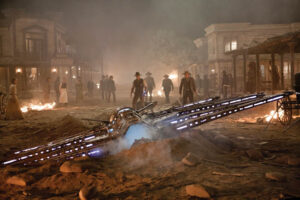
Favreau adds that the Comic-Con presentation was exactly what the doctor ordered, because fan interest at such events changes every year in various ways. Therefore, the exercise required Lebental and him to find devices that would honor both classic Western pacing, and yet be contemporary enough for the sci-fi crowd.
“Audiences today tend to metabolize more cuts and shorter cuts,” the director says. “The flip side is that if they are not stimulated enough, they become bored. The question was: How to achieve the same effect of the classic Western but create a pacing that does not feel lethargic to them, and is still vital and relevant? Comic-Con and screenings that followed were great for that because we pre- viewed 40 minutes of the film, got input from our target audience and were later able to cut those scenes down to about 25 minutes.
“That is the nature of notes in these things,” Favreau continues. “In the script stage, notes are about what you want to add in. In the editorial phase, notes are about what you want to get rid of—things that, even if they are well done, might interfere with the rhythm of the piece. We removed a lot of things over the course of the cutting process for that reason.”
Pushing for Perspective
As usual, Lebental had a well-organized and familiar team, led by his veteran first assistant editors Dawn King and Sandra Granovsky, handling the technical end of things—data management, etc.— leaving him free to work on his initial assembly throughout the shooting phase on an Avid Media Composer (5.0.3.5) system. The production ended up using seven Media Composer stations among the two editors, assistants and visual effects requirements. The filmmakers frequently reviewed and screened dailies footage directly out of the Avid or on D5 tape in the DHX36 HD format.
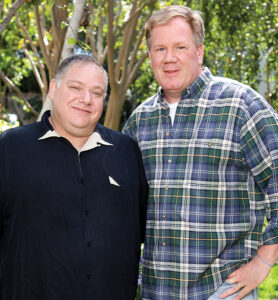
Over the course of the editorial phase, a new perspective from May was added after he joined the project, and Favreau even invited Spielberg and fellow producer/director Ron Howard into the editing room to offer suggestions. But before most of that additional input, the initial cut of over three hours largely consisted of an opportunity for Favreau to see how Lebental would interpret the material on his own.
“We have a gentlemen’s agreement on that,” says Lebental. “It’s important that he see what I would do based on my first instinct, especially in the style we shot, with lots of different angles. Rather than just prescribe it for me, he’d rather see what I would bring to the table, and then direct from there.”
“The editorial process is so long that it is easy to lose perspective,” Favreau adds. “Having fresh POVs in the editing room is important. But core to that conversation is what goes on between director and editor––especially in the case of Dan and myself. His first assembly is an opportunity to show me his perspective based on what we gave him. Being on set so much does not always give me the best insight into what I’ve shot, so he helps remind me that sometimes the solution is outside of what I had in mind.”
Favreau’s respect—and need—for Lebental’s input is so strong, in fact, that the director has been known on several films (including this one) to re-shoot footage or shoot entirely new footage when feasible, based on the editor’s input. “He comes to the set and shows me when he feels he needs something else to get a scene done, and he’ll give me a wish list of shots,” says Favreau. “I usually get him the footage to finish the scene. We have that level of trust, and it comes from knowing someone’s sensibility. If he asks for something, I know where he’s coming from and I put it on my agenda to con- sider getting less of what I wanted on a particular day if it’s something Dan is adamant about.”
The Effects Factor
The intensely close relationship between Favreau and Lebental wasn’t the only thing familiar about the Cowboys & Aliens cutting process, however. Both men were well versed in dealing with major visual effects in partnership with Industrial Light & Magic after their experiences on the two Iron Man movies helmed by Favreau.
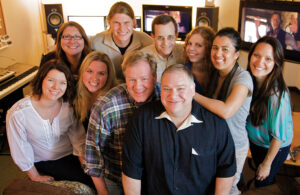
Indeed, Favreau says he could never have possibly made Cowboys & Aliens were it not for the lessons he and his team learned on both Iron Man films. In the case of this film, however, adding an experienced effects and editing professional like May to the mix allowed that process to be more efficient than on those earlier efforts. Over time, May’s role expanded as he became accustomed to Lebental’s cutting pace and process, but his knowledge of visual effects proved particularly invaluable.
The editors say that their ability to work intimately with ILM to get enough information to choose and hone evolving visual effects shots was central to the project’s success. “For the editors, with a show involving complex creature animation like this one, clearly there needs to be a tremendous amount of collaboration with the visual effects supervisor,” May explains. “Often, you are animating and editing down to the individual frames within the shot.”
Lebental feels the role of the editor has changed in recent years when it comes to large tentpole effects films, simply because of the reality that final effects shots—usually crucial to a film’s success—are typically not going to be done ahead of the editorial process, and often long after it. “That’s just part of the gig now on these kinds of films,” he says. “Now, the editor is asked to be part and parcel with planning and creation. On some movies, I’m brought in to cut pre-visualization animation before the movie is ever shot.
“Classically, the editor doesn’t want to do that because he likes to be the independent catcher of the material, keeping a totally objective eye and not having a vested interest in what is coming to him,” he continues. “But the reality is that the cost of these effects action pieces requires proper planning to save millions of dollars and get everything right.” Economics now require editors to be part of the process earlier and longer than in the past.
“As an editor on these films, you are more involved in planning, while still trying to stay objective and honest when telling the directors something stinks, or is great, or is needed or isn’t; that’s just part of the modern editor’s job on big movies,” Lebental concludes. “But when you work with a director like Jon––who values your opinion so highly and gives you room to challenge his––it works out great.”



